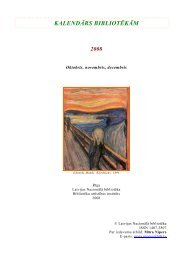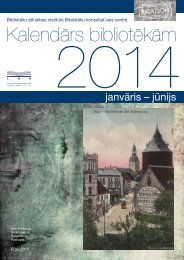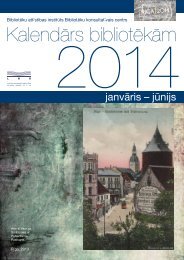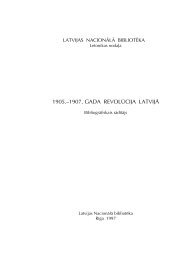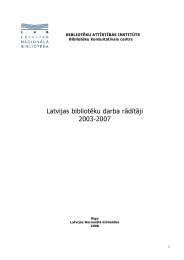LAIKU ATŠALKAS: ŽURNĀLISTIKA, KINO, POLITIKA - Academia
LAIKU ATŠALKAS: ŽURNĀLISTIKA, KINO, POLITIKA - Academia
LAIKU ATŠALKAS: ŽURNĀLISTIKA, KINO, POLITIKA - Academia
You also want an ePaper? Increase the reach of your titles
YUMPU automatically turns print PDFs into web optimized ePapers that Google loves.
<strong>LAIKU</strong> ATŠALKAS: ŽURNĀLISTIKA, <strong>KINO</strong>, <strong>POLITIKA</strong>Prof. Inta BrikšeUniversity of Latvia, Department of Communications StudiesDOGMAS AND IDENTITY: SOVIET LATVIAN JOURNALISMIN THE 1970SKeywords: Soviet journalism, principles of Soviet journalism, functions of Soviet journalism, genres, identityThe 1970s were a period of intensive processes in Soviet journalism – ones which had to dowith changes in ideological technologies from unidirectional public communications to managementof communications processes, including the media and journalists in the system of breedingSoviet people.This paper offers an analysis of the theoretical concepts of Soviet authors from the 1970s whenit came to the principles of journalism and the practices of journalism in Soviet Latvia, makinguse of theoretical considerations and articles written by journalists in which they analysed theirown professional identities. 1The study shows that the understanding of the identity of Soviet Latvian journalists developedvia an unclear and contradictory discourse which was shaped by the dogmatic nature of Sovietideology, the theoretical concepts of Soviet media outlets and journalisms, and the identity constructedin practice by journalists themselves. This had to do with individual understandingsabout the meaning of the profession, as well as about the techniques and rules for producingjournalistic texts. Soviet Latvian journalism was a part of the Communist Party’s ideology interms of politics, but in professional terms, it involved a balance between liberal journalism andthe practices of amateur journalism.The corporative environment of journalism was split up for this reason, because there weredifferences in the identities which journalists established for themselves, the identities that werecommunicated at different media outlets, and the understanding of the formats, genres, etc., ofthe work of journalists. A legitimising identity was accepted in a formal sense, but resistanceidentity and project identity were unclear, because there was an absence of an open public spacefor their interaction – something which is a prerequisite for the construction of social identities.The processes were deepened even more by the fact that editorial offices were populated notjust by party activists and/or people with literary skills, but also by increasing numbers of peoplewho were trained for professional purposes at universities and were thus encouraged to statetheir professional belonging to the field of journalism. That was because Soviet universities atthat time were establishing educational programmes in journalism.1Gavars, V. (ed.). Žurnālisti par žurnālistiku (Journalists on Journalism). Rīga: Liesma (1977).218



